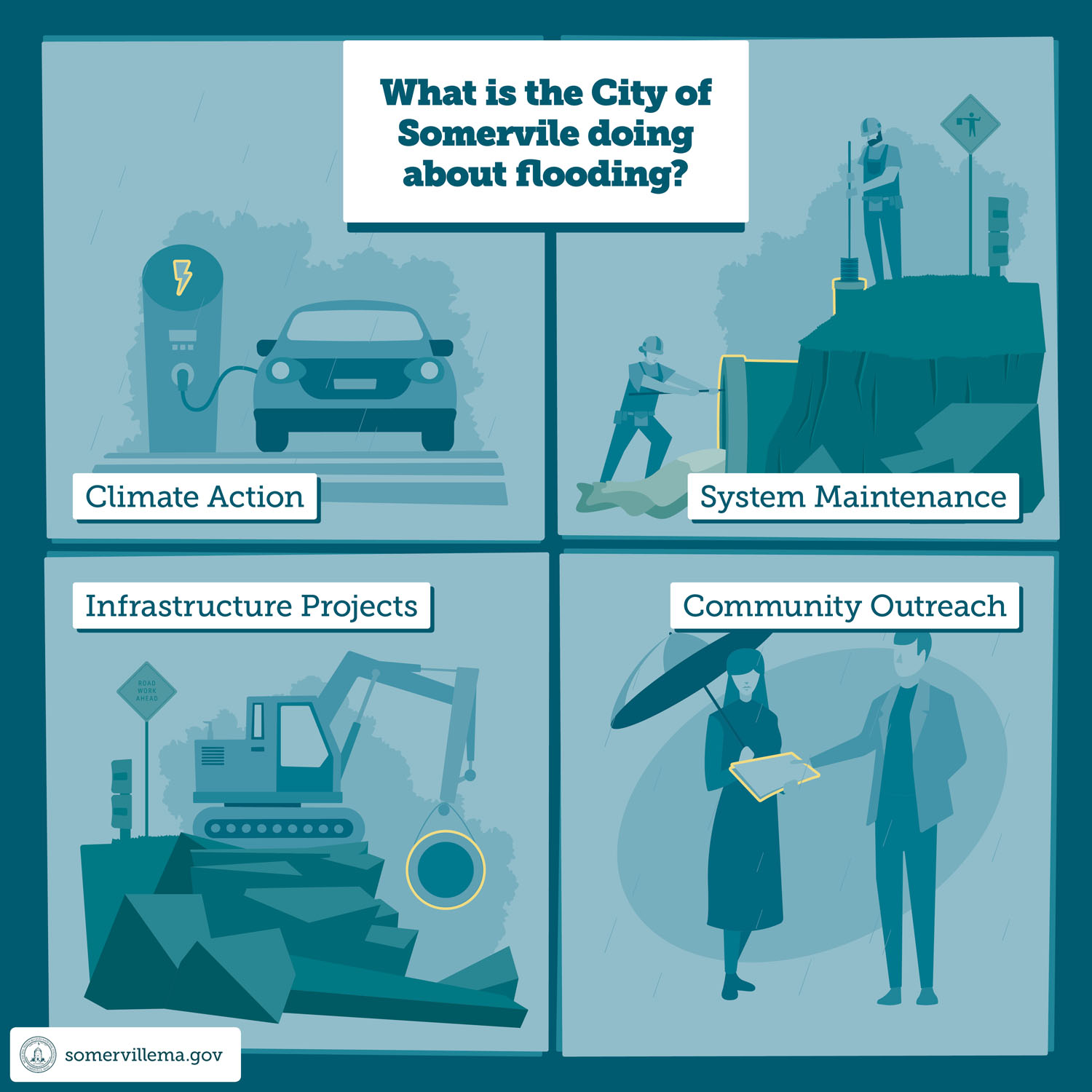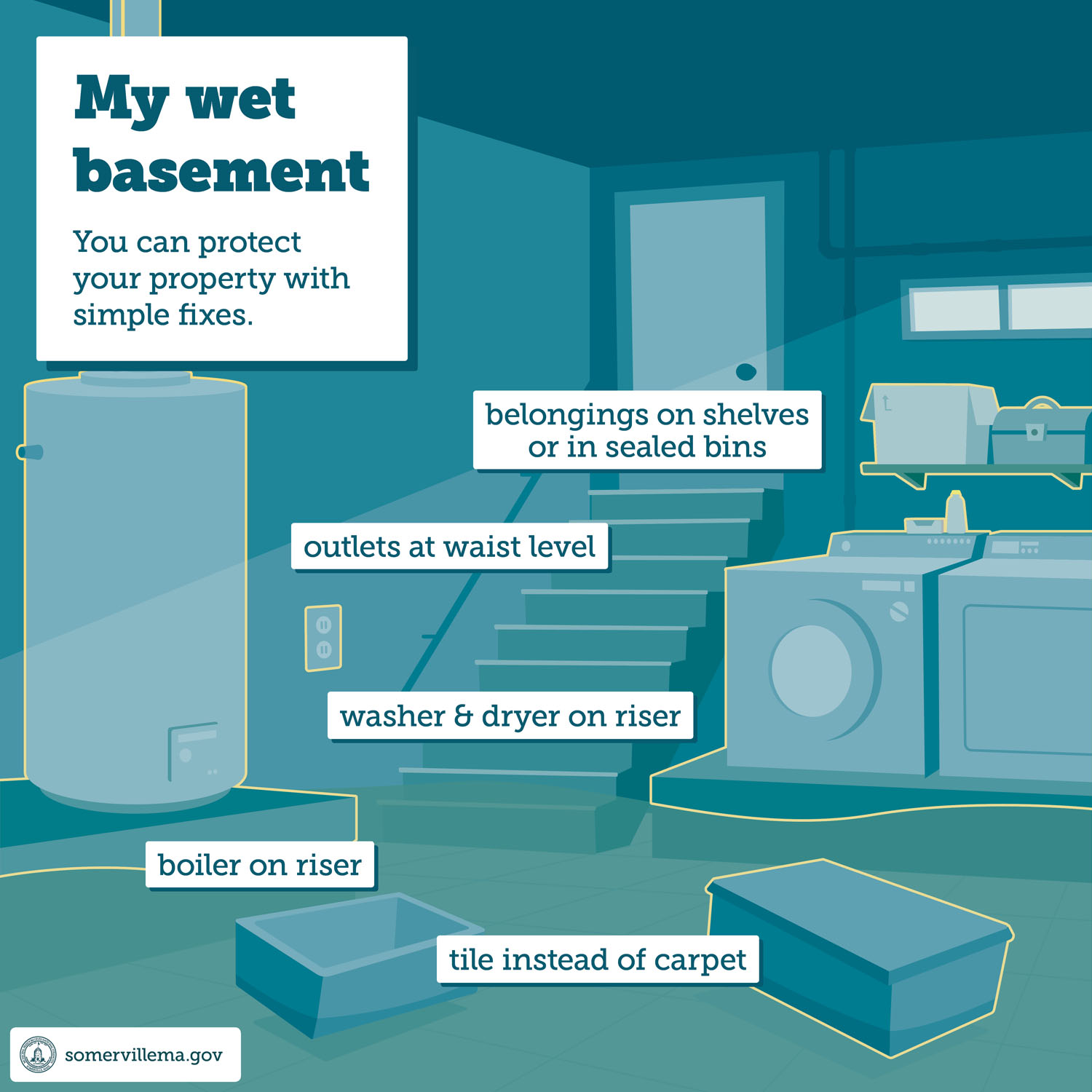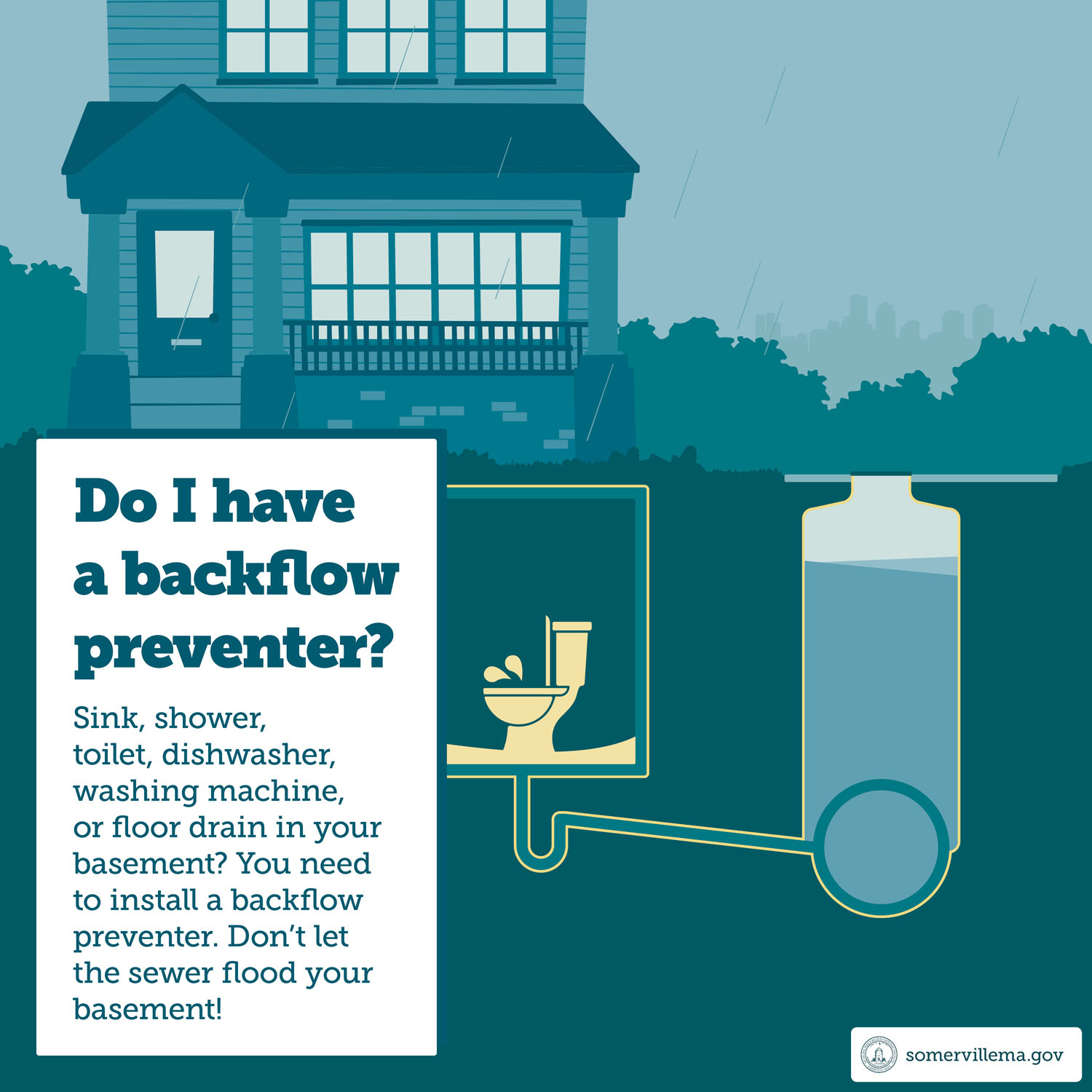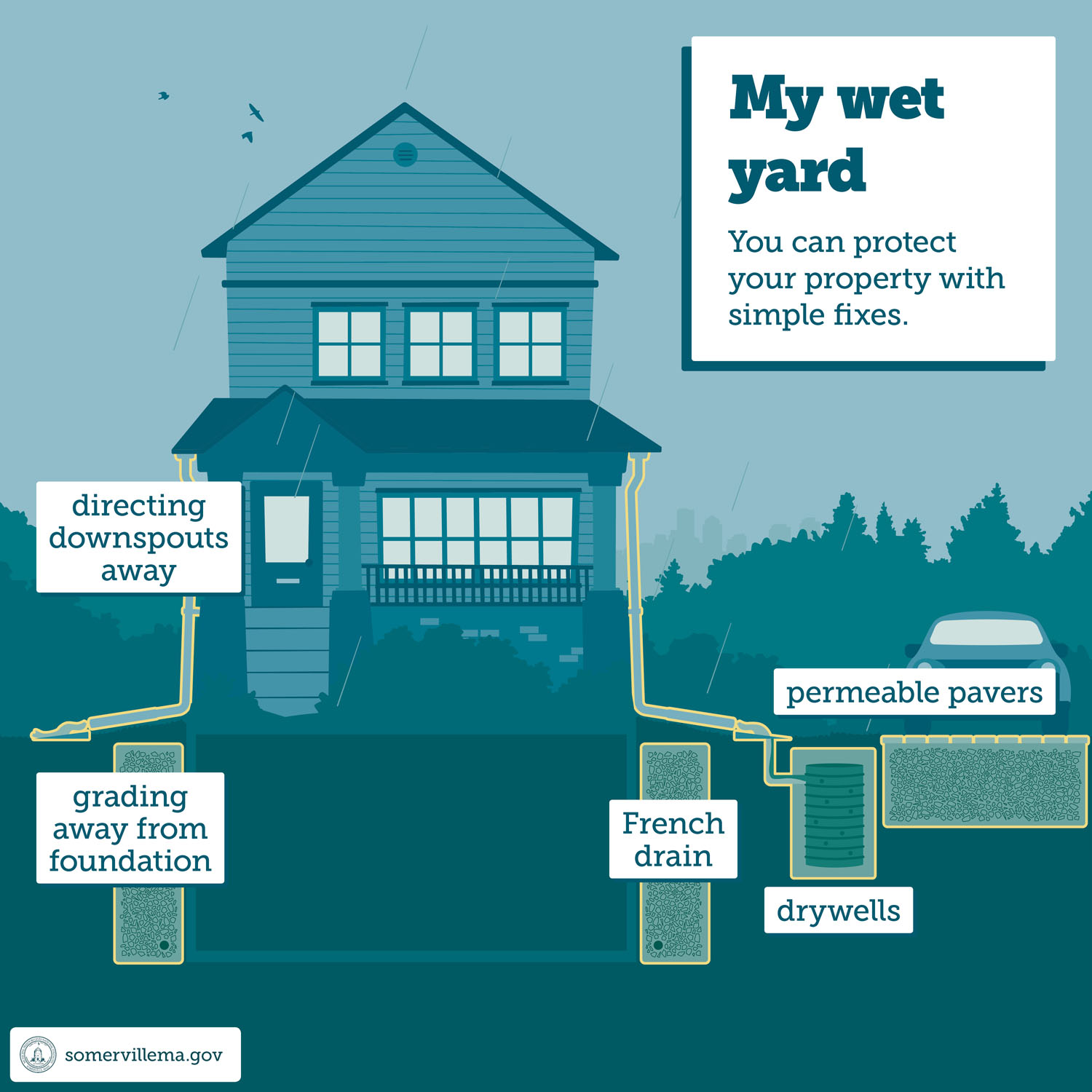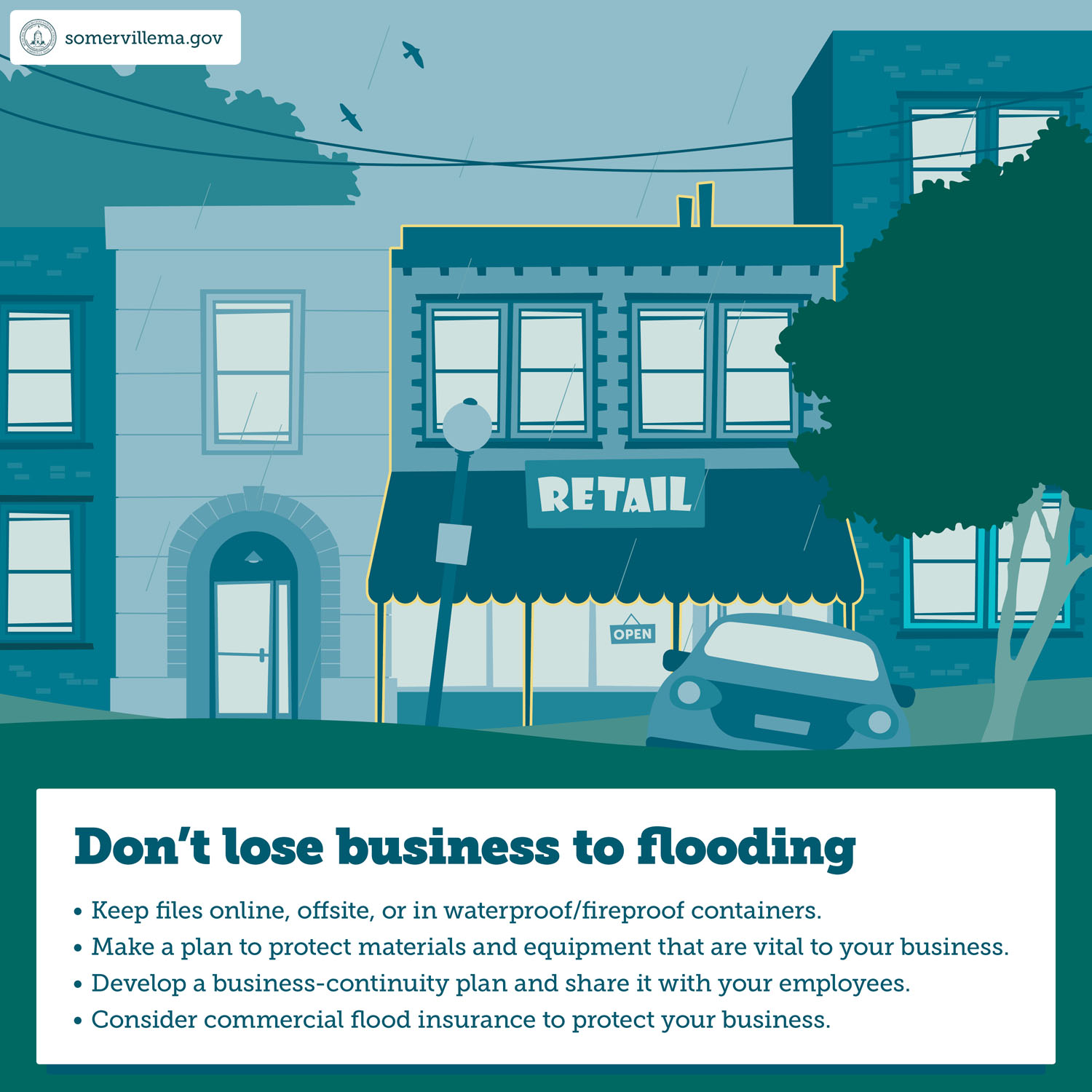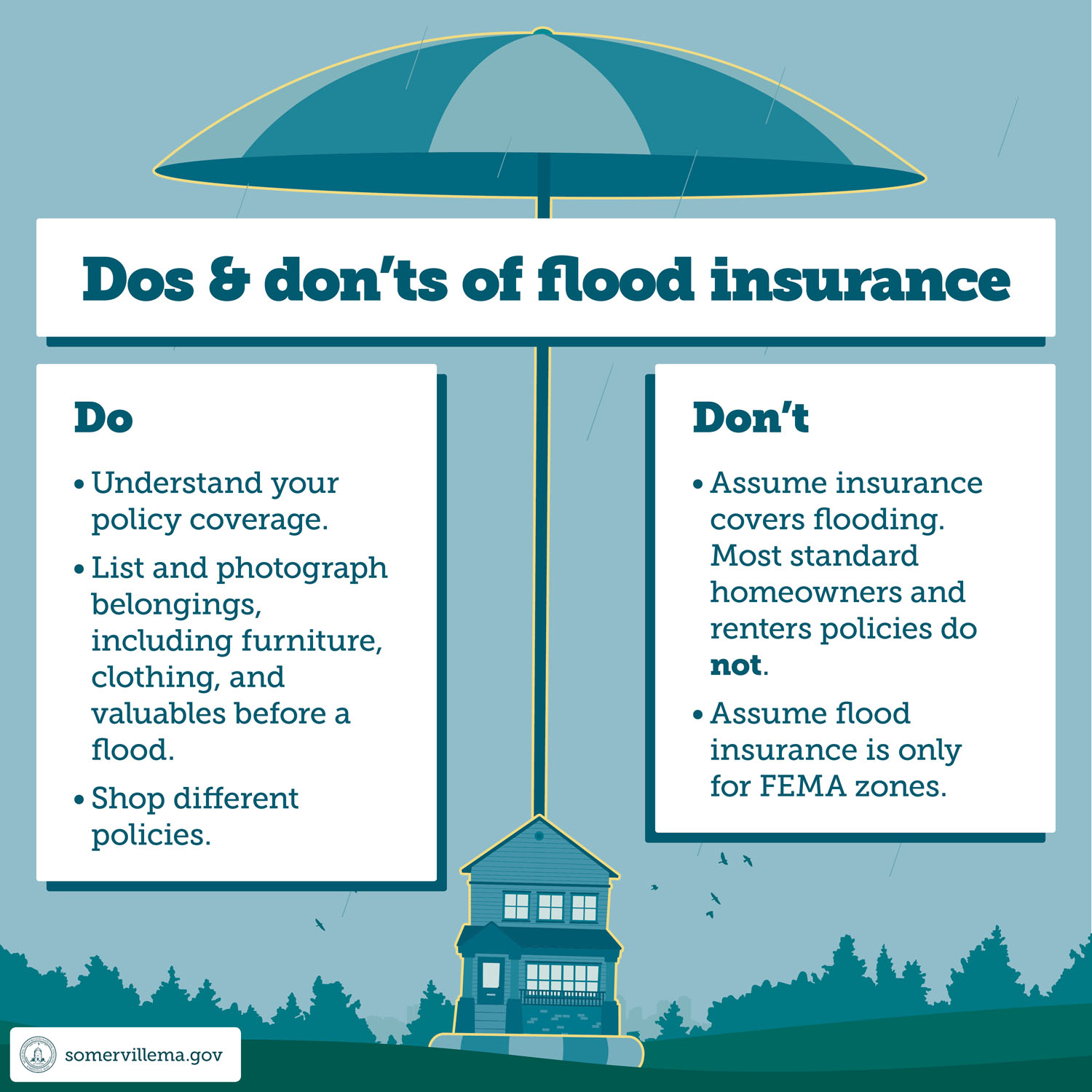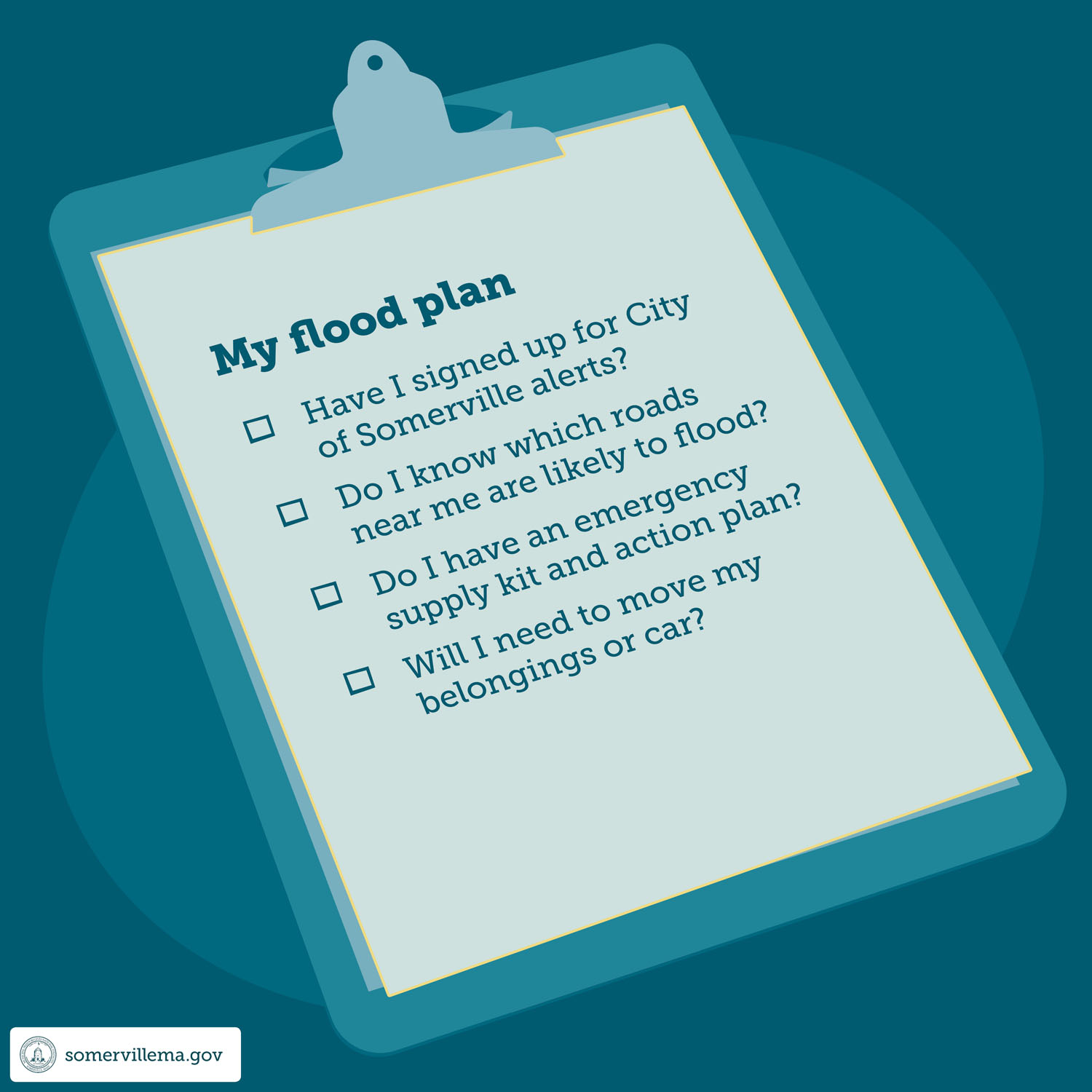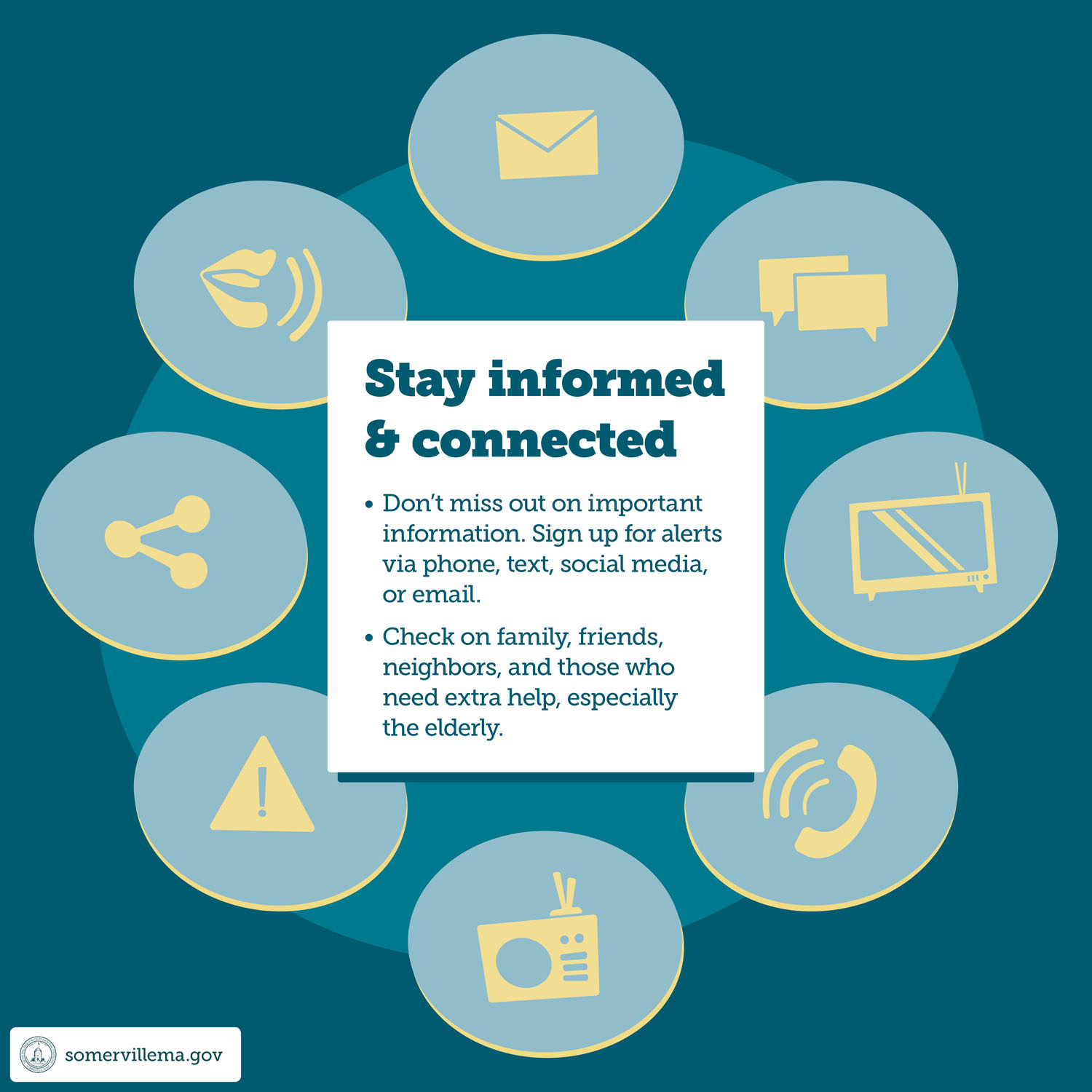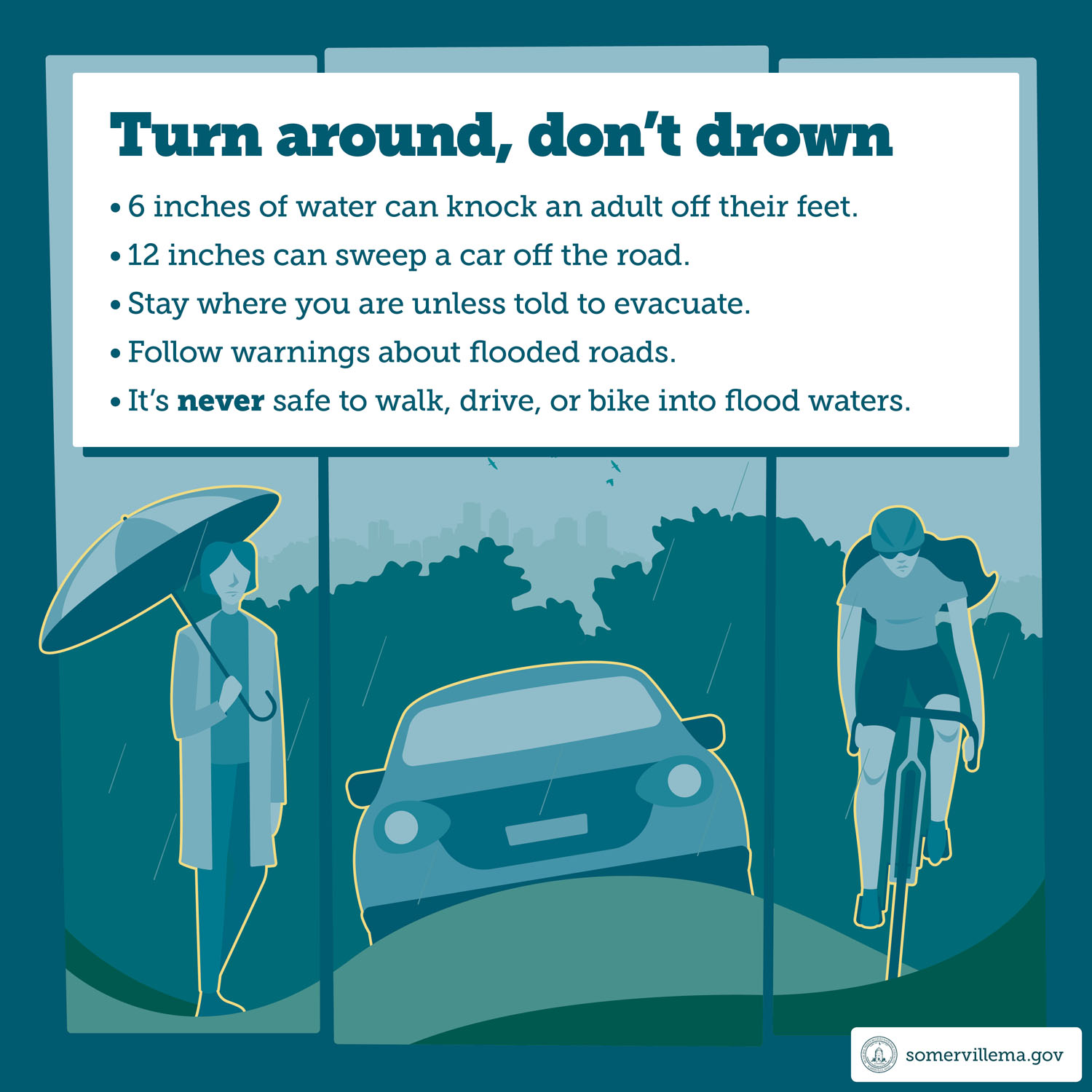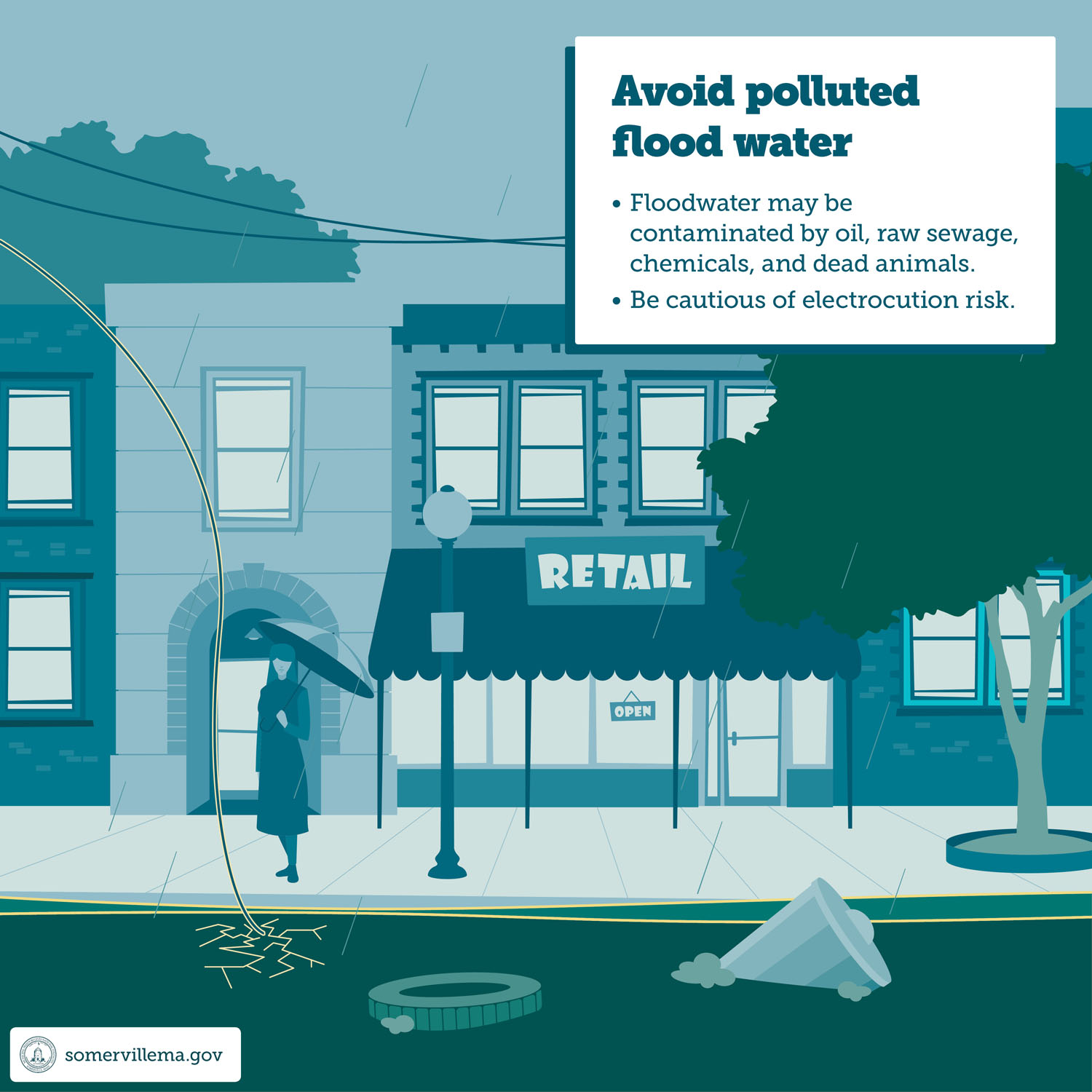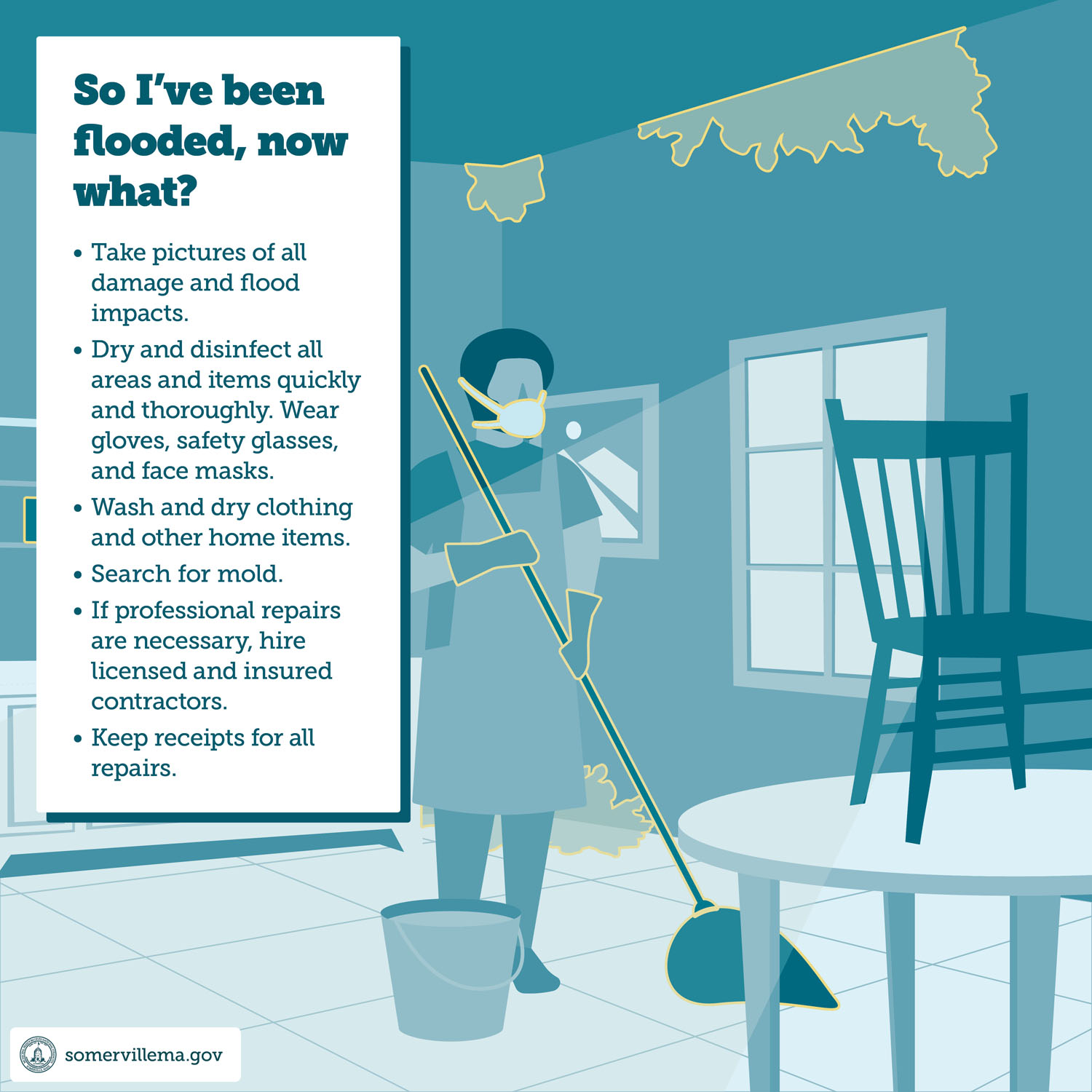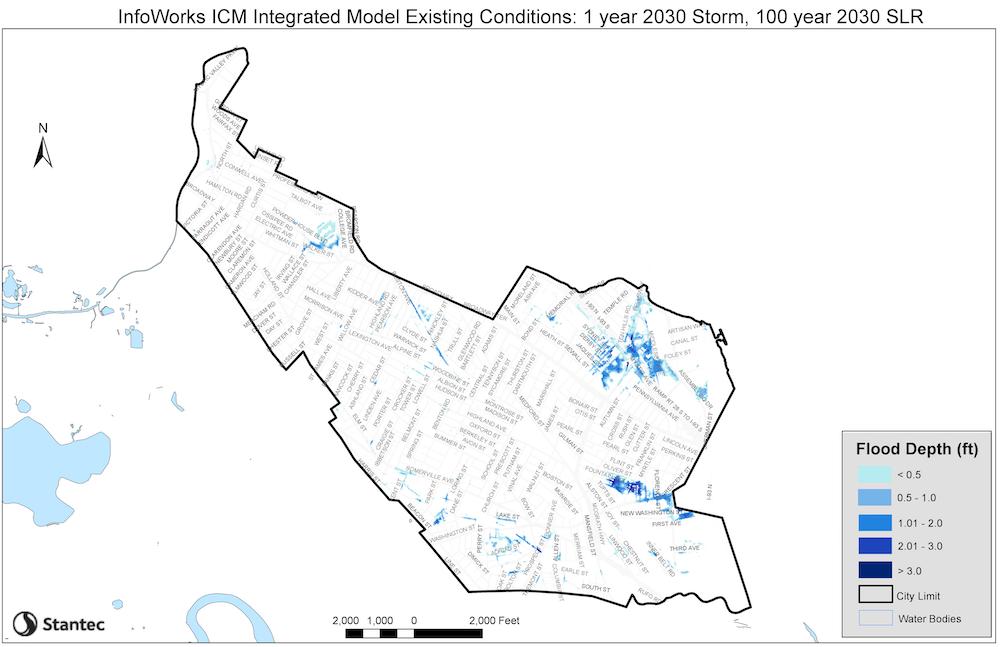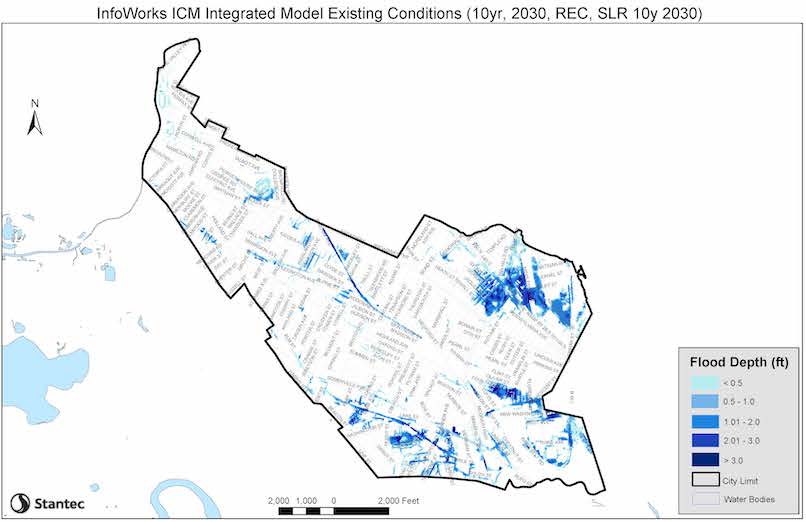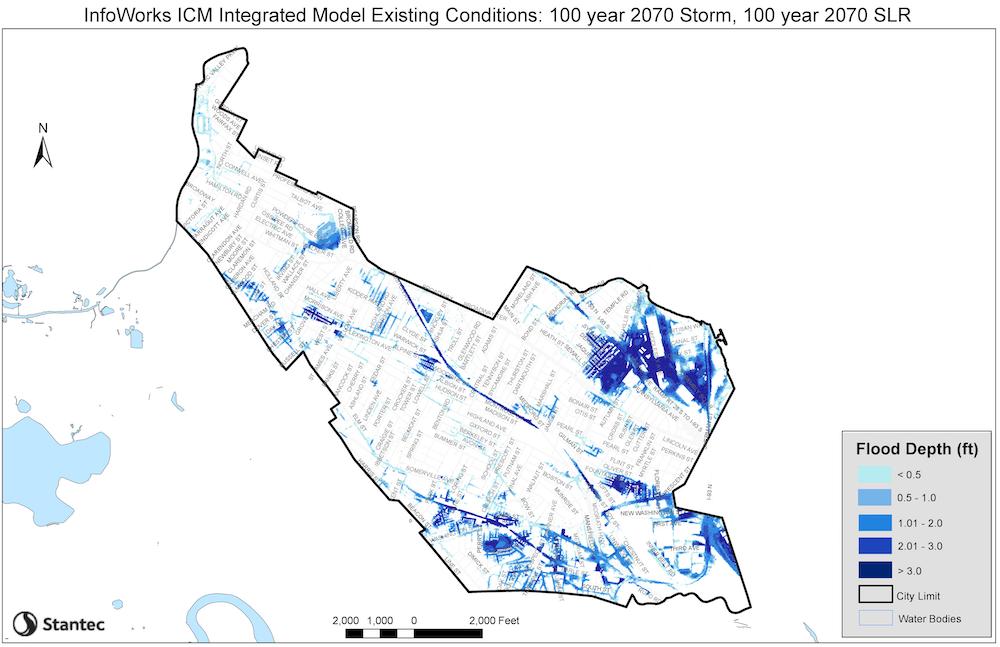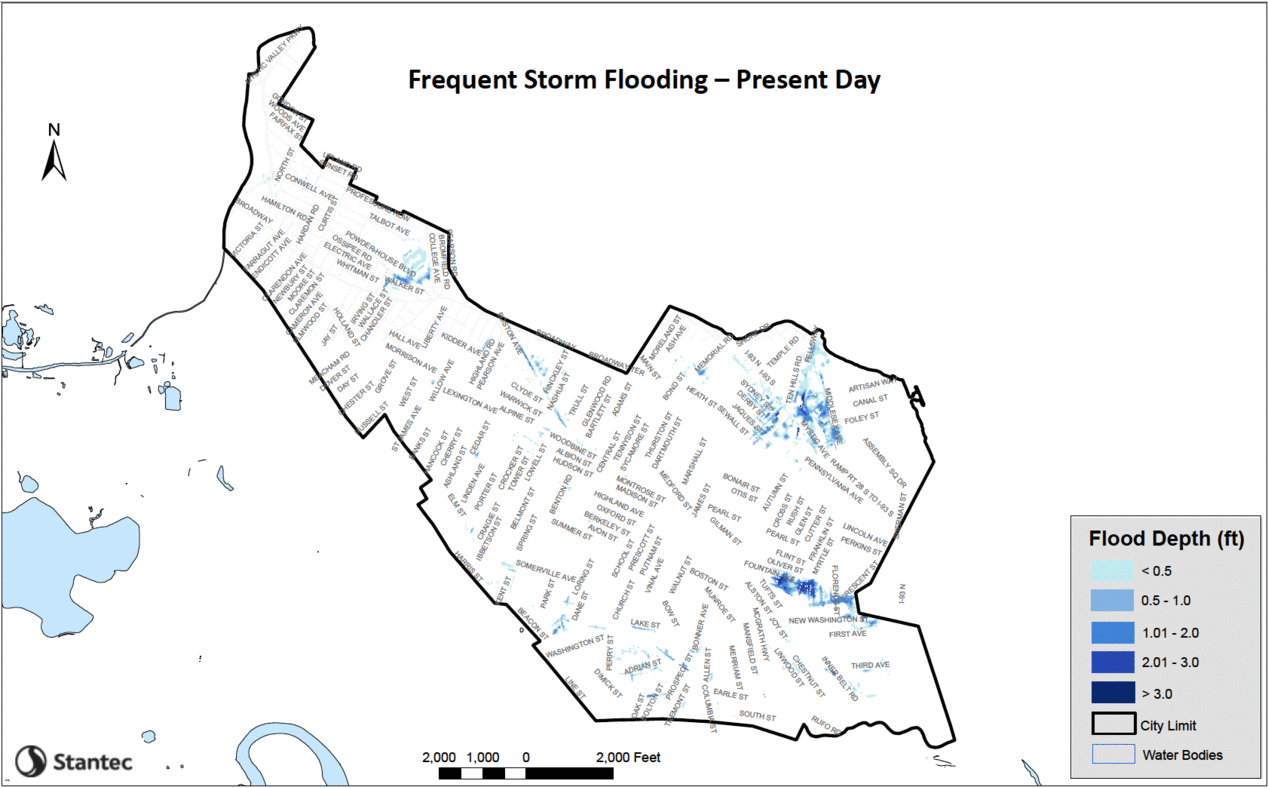Flood Ready
There are many factors that can lead to flooding, and also variable levels of what is considered “flooding.” Whether neighborhoods experience consistent water backups on streets and sidewalks following rainstorms, or water rises in excess of several feet in low-lying areas, these are issues we are actively working to address at the municipal level.
Mitigating, Planning, and Preparing
In the short term, we can work to control or mitigate minor flooding through typical city services like regularly scheduled street sweeping, clearing catch basins, and properly maintaining sewers. In the longer term, we are making significant investments in and upgrades to our aging infrastructure. Projects across the city like the Somerville Ave. Utility and Streetscape Improvements Project, the Marginal Interceptor Rehabilitation Project, and ongoing sewer inspection and rehabilitation projects will not only upgrade our combined sewer system, but also greatly enhance capacity for stormwater management.
Finally, and perhaps the most critical factor impacting flooding, is the fact that climate change is causing Somerville to experience more frequent and intense rainstorms, which leads to more flooding, including in places that typically do not experience flooding. The City of Somerville, partner agencies, and community advocates are actively working to address and prepare for climate change in a number of ways. In late 2018, we released Somerville Climate Forward, our first comprehensive climate change action plan, with implementable actions to reduce Somerville’s contribution to climate change. You can view the full plan at somervillema.gov/ClimateForward.
The City of Somerville is actively planning for the effects of climate change and making improvements to our aging infrastructure, but it is also important that residents, business owners, and developers take the necessary steps to prepare your properties in advance of potential flooding. Learn more here about what is happening in Somerville, whether your home or business is at risk, and how to respond before, during, and after a flooding event.
Contact Information
Jump To:
The City is working on flood mitigation solutions, maintenance of our stormwater management system, community outreach, and preparedness, and climate action. A wide range of strategies are needed in order to address flooding. Current examples of flooding preparedness projects and efforts in Somerville include:
Stormwater Infrastructure Improvements and Maintenance
During intense precipitation events, some areas of Somerville currently experience flooding, often resulting in flooded streets and wet basements. This flooding occurs when Somerville’s current drainage system does not have the capacity to manage the large quantities of water that fall over a short period of time during a storm. The City is working to better maintain the stormwater drainage system and implement new projects that will expand the capacity of the system, primarily through the work of multiple departments:
- The Water and Sewer Department is responsible for maintaining Somerville’s stormwater management system, including cleaning catch basins.
- The Department of Public Works is responsible for street sweeping and clearing leaves and debris from catch basin surfaces.
- The Engineering Division is responsible for implementing stormwater infrastructure improvement projects. Key elements of its work plan include:
- Citywide Infrastructure Upgrades: Projects like the ongoing Somerville Ave. Utility & Streetscape Improvements Project in Union Square will modernize our water and sewer systems and greatly increase the City’s capacity when complete. Without the new infrastructure provided by the Union Square project, it would be virtually impossible to provide a solution for other locations in the City.
- Accelerated Pipe Inspections: To identify system repairs that will increase capacity and reduce flooding, we must first conduct a condition assessment program, which involves a thorough cleaning of pipes and internal pipe inspections utilizing closed-circuit cameras. In July 2020 we awarded the first inspection contract, the largest such contract in the City’s history, for 34 miles of pipe in the area between Somerville Avenue and the Cambridge border. Work on that contract will begin in Summer 2020, as will planning for next year’s inspection contract.
- Funding for Repairs: As the condition assessment program identifies issues, repairs will be designed and prioritized. Repairs that reduce legacy flooding will be given high priority, and the budget planning that informs our Water & Sewer rate recommendations assumes that every year will include contracts to address those needs.
- Citywide Drainage and Water Quality Master Plan: Given the complex nature of our combined sewer and drain system, more substantial flood reduction will require larger systematic improvements. In February 2020, the City began formalizing a Citywide Drainage and Water Quality Master Plan, which includes field and video inspection of structures and pipes, installation of real-time data gathering equipment, reviewing flood records, an update of the City’s hydraulic model, and solution development and analysis.
- To learn more and see current projects, visit somervillema.gov/Engineering.
Climate Change Preparedness & Resilience
Climate change means that flooding will happen more often and more intensely, including in places that haven’t experienced flooding in the past. This increase in flooding will happen for two different reasons. First, there will be more frequent and intense rainstorms, with a predicted 30% increase in rainfall during a 100-year, 24-hour event by 2070 (Somerville Climate Vulnerability Assessment, 2017). A 100-year storm has a 1% chance of occurring in a given year.
Second, Somerville will experience flooding from the Mystic River. As sea levels in Boston Harbor are predicted to rise 4 to 8 inches by 2030 and 15 to 36 inches by 2070 (Climate Ready Boston, 2016), the risk of flooding in Somerville during large coastal storms will increase because the existing infrastructure is not designed for these future conditions. The City of Somerville is continuously analyzing climate projections in order to understand how climate change will affect Somerville and how we can better prepare. To find out more about how current and future flooding might impact your home, business, and nearby roads, view Somerville’s flood risk maps at the “Flood Maps and Information” tab on this page. To learn more about potential climate change impacts in Somerville, and what the City is doing to prepare, check out these resources:
- City of Somerville's Climate Change Vulnerability Assessment
Along with Somerville’s Greenhouse Gas Inventory, this assessment helped establish the baseline understanding of Somerville’s contribution to climate change and anticipated impacts from climate change for use in the City’s Climate Change Plan. The assessment looks closely at the city’s risks from sea-level rise and storm surge, precipitation-based flooding, and increasing temperatures, and it identifies priorities in order to reduce these climate-related risks. - City of Somerville Climate Forward Website and Community Climate Change Plan
Somerville’s first climate change plan, with a set of implementable actions that will reduce Somerville’s contribution to climate change and prepare the City for the unavoidable impacts of climate change.
More Information
- Frequently Asked Questions
- Climate Change Basics from SustainaVille
A primer on climate change, what it means for Somerville, and what we can do about it. - Massachusetts Climate Change Clearinghouse (Resilient MA)
Maps, data, and reports from the State of Massachusetts on their climate change-related projections and planning.
The City of Somerville currently experiences different levels of flooding, from frequent flooding of basements to more extreme flooding events during intense rainstorms. To help you prepare your property for all kinds of flooding, we’ve created some visual examples that illustrate some important steps you can take. Explore the information in the graphics below.
If your basement is subject to flooding, consider wet floodproofing by installing water-resistant finishing materials (like tile and concrete). This is practical only for non-living spaces, such as basements, crawlspaces, or garages. For living spaces, take a look at FEMA’s guide on dry floodproofing. What else can you do to limit flood damage?
- Remove valuables, sentimental items, and important documents from your basement, and store your belongings off the floor on risers/shelves or in sealed bins.
- Install a sump pump and backflow preventers.
- Elevate electrical outlets to higher areas on the wall, as there is a danger of being unable to shut off the electrical panel after it floods.
- Relocate utilities including the electrical service panel and the heating, ventilation, and air conditioning (HVAC) ductwork.
Flooding on your street could cause sewers to back up through your pipes and flood your basement with sewage. Do you have a sink, shower, toilet, dishwasher, washing machine, or floor drain in your basement? Do you own a basement-level apartment or condo? If so, you may need a professional plumber to install a backflow preventer to prevent sewage from flowing backwards into your basement.
How can you keep your yard and foundation dry?
- Grade your yard so that it slopes away from the foundation.
- Maintain downspouts and gutters, extend them away from the foundation, and have them discharge onto a splash pad.
- Install French drains to convey water away from the foundation, and dry wells to store and infiltrate rainwater.
- Utilize permeable pavement to better infiltrate rainwater from driveways and patios.
Following a disaster, 40% to 60% of small businesses never reopen their doors, and 90% fail within a year unless they can resume operations within five days (FEMA). Explore FEMA’s Ready Business website for more information, including an Inland Flooding Toolkit.
Standard homeowner’s and renter’s insurance policies do not include flood insurance, but you can contact your insurance company for more information about adding flood protection. If your agent does not sell flood insurance, you can contact the National Flood Insurance Program’s Help Center at 1-800-427-4661 for a referral.
Before Flooding Occurs
Taking proactive measures to prepare before a flood occurs can help keep you and your property safe. It is important to have plans for both frequent, recurring flooding from major rainstorms and the less frequent but more catastrophic flooding events like a major coastal storm.
Preparing for a flooding event is much like preparing for a major snowstorm. You should have a communication and emergency response plan in place with your family or household and have gathered emergency supplies (including for your pets) in case you need to leave your home for a period of time. It is important to consider the unique needs of all members of your household, including children, seniors, and individuals with disabilities, in your preparations.
Subscribe to Somerville alerts to receive important City-specific information and pay attention to weather alerts on your phone, the radio, and TV.
Apart from the long-term preparedness strategies described in the resources above, other actions you should take immediately before a potential flooding event are:
- Secure outdoor objects (including furniture, trash cans, etc.) or bring them inside.
- Clear your basement of hazardous waste.
- Report street catch basins covered in debris to 311 so they can be cleared to prevent or reduce street flooding.
- Take care when parking your vehicle to minimize potential water damage.
- Follow any directives to turn off utilities, including the main power source (by flipping each breaker and then turning off the main breaker) and the main valve for gas and water service.
Resources
- FEMA’s “How to Prepare for a Flood”
- MA Resources to Prepare for Emergencies, including: Make a Family Emergency Plan, Build an Emergency Kit, and Prepare for Pets and Animals
- Red Cross Flood Preparedness
There are many things you can do to keep you and your family safe during a flooding event. Explore the following information to learn more about what you should and should not do.
It is never safe to walk, drive, or bike into floodwaters. It is impossible to know how deep the water is just by looking at it. If you do get trapped in your vehicle in rapidly moving water, do not exit the vehicle, and call 911. If water is rising inside the vehicle, seek refuge on the roof of the vehicle, and call 911.
Avoid wading in floodwater, which may contain debris and be contaminated. Be aware of the risk of electrocution – underground or downed power lines can electrically charge the water.
Pay attention to alerts from MEMA and the National Weather Service to receive important information about flood hazards.
Due to climate change, in the future, Somerville will experience increased flooding in two different ways: from intense rainstorms, and from sea-level rise and storm surge along the Mystic River. During a potential flooding event, pay attention to local weather reports, alerts, and NOAA Weather Radio to better understand how it might affect your home or business. Avoid travel, if possible, and shelter in a safe place, make sure your valuables and important documents are protected from floodwaters and gather your emergency kit so that you are prepared. If you are caught in a flood and require emergency assistance, please call 911. If it is not an emergency but you need assistance or have questions, please call 311 (617-666-3311 from cell phones, or landlines outside of Somerville). Lastly, you can share flooding photos and updates with the City at flooding@somervillema.gov to inform future flood reduction projects.
Do what you can to prevent further damage that insurance may not cover (e.g., by putting a tarp on a damaged roof). Clean and disinfect everything that got wet. Water and debris left from floodwater can contain sewage, bacteria, and chemicals. Take precautions and wear appropriate protective equipment such as gloves, safety glasses, and face masks. Follow five basic steps for post-flood building restoration, including (1) air out, (2) move out, (3) tear out, (4) clean out, and (5) dry out.
Seek out professional services and/or guidance before attempting to repair flood-damaged property. Be aware of the risk of electrocution and do not touch electrical equipment it if is wet or if you are standing in water. Remove and replace any drywall or other paneling that has been underwater. Use a moisture meter to make sure that wooden studs and framing are dry before replacing the drywall. Mold growth, often in hidden places, is a significant health hazard.
Throw out any medicine, water, or food (including canned items) that was exposed to floodwaters or not maintained at a proper temperature. Do not eat food from a flooded garden. When in doubt, throw it out.
If you have flood insurance and want to file a flood claim, photograph damage to your property and contact your insurance agent. You can also visit the National Flood Insurance Program’s website for more information on filing a flood claim.
The map layers identify areas that are more vulnerable to flooding but do not indicate every possibility of future flooding. Some areas might experience more flooding and some areas might experience less flooding depending on the storm conditions and other variables. Additionally, these maps show future flooding predictions given no change in Somerville’s infrastructure. As the City of Somerville implements stormwater infrastructure projects, these predictions will need to be updated to reflect those infrastructure improvements.
These maps look at three different timescales to show projections over time: present-day, 2030, and 2070. The future years are used as benchmarks, but the change represented is a gradual change over time, meaning that flooding will increase leading up to 2030 and then again until 2070, and beyond. The maps also show three different types of storms: a 1-year storm event, which has a 100% chance of occurring in any given year, a 10-year storm event, which has a 10% chance of occurring in any given year, and a 100-year storm event, which has a 1% chance of occurring in any given year.
This map shows the impact of precipitation-based flooding, with modeled flood depths of a 1-year (100% chance of occurring in any given year), 6-hour storm in the present day. This map includes modeling of the current drainage systems.
Frequent Storm Flooding – Present Day
This map shows the impact of both precipitation-based flooding, and sea level rise and storm surge, with modeled flood depths of a 10-year (10% chance of occurring in any given year), 24-hour storm with 10-year (10% chance of occurring in any given year) storm surge and sea level rise projections in 2030. This map includes modeling of the current drainage system.
Moderate Storm Flooding – 2030
This map shows the impact of both precipitation-based flooding, and sea level rise and storm surge, with modeled flood depths of a 100-year (1% chance of occurring in any given year), 24-hour storm with 100-year (1% chance of occurring in any given year) storm surge and sea level rise projections in 2070. This map includes modeling of the current drainage system.
Extreme Storm Flooding – 2070
This image is a progression of three maps over time from the present day to 2030 to 2070, with worsening flooding conditions. They show the impact of both precipitation-based flooding, and sea level rise and storm surge. The “Frequent Storm Flooding – Present Day” is of modeled flood depths of a 1-year (100% chance of occurring in any given year), 6-hour storm in the present day. The “Moderate Storm Flooding – 2030" is of modeled flood depths of a 10-year (10% chance of occurring in any given year), 24-hour storm with 10-year (10% chance of occurring in any given year) storm surge and sea level rise projections for 2030. The “Extreme Storm Flooding – 2070" is of modeled flood depths of a 100-year (1% chance of occurring in any given year), 24-hour storm with 100-year (1% chance of occurring in any given year) storm surge and sea level rise projections in 2070. These maps include modeling of the current drainage system.
Progression of Flooding from Frequent to Extreme – 2030 to 2070
For any questions regarding the maps and the information they contain, please email engineering@somervillema.gov or call 617-625-6600 x5400.
Feedback
Please submit website feedback using this form. Be sure to include:
Thank you for your feedback!

